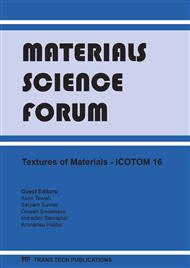[1]
T. Watanabe, An approach to grain boundary design for strong and ductile materials, Res. Mechanica 11 (1984) 47-84.
Google Scholar
[2]
T. Watanabe, Structural effects on grain boundary segregation, hardening and fracture, J. Phys. C4 (1985) 555-566.
DOI: 10.1051/jphyscol:1985462
Google Scholar
[3]
H. Lin, D.P. Pope, (1993): The influence of grain boundary geometry on intergranular crack propagation in Ni3Al, Acta Metall. Mater., 41 (1993) 553-562.
DOI: 10.1016/0956-7151(93)90085-7
Google Scholar
[4]
G. Palumbo, K.T. Aust, Structure-dependence of intergranular corrosion in high purity nickel, Acta Mater. 38 (1990) 2343-2352.
DOI: 10.1016/0956-7151(90)90101-l
Google Scholar
[5]
J.Q. Su, M. Demura, T. Hirano; Grain boundary fracture strength in Ni3Al bicrystals, Philos. Mag. A, 82 (2002) 1541-1557.
DOI: 10.1080/01418610110118359
Google Scholar
[6]
D.C. Crawford, G.S. Was, The role of grain boundary misorientations in intergranular cracking of Ni-16Cr-9Fe in 360°C argon and high purity water, Metall. Mater. Trans. A 23 (1992) 1195-1206.
DOI: 10.1007/bf02665051
Google Scholar
[7]
V.Y. Gertsman, S.M. Bruemmer, Study of grain boundary character along intergranular stress corrosion crack paths in austenitic alloys, Acta Mater. 49 (2001) 1589-1598.
DOI: 10.1016/s1359-6454(01)00064-7
Google Scholar
[8]
T. Tanaka, S. Tsurekawa, H. Nakashima, H. Yoshinaga, Misorientation dependence of fracture stress and grain boundary energy in molybdenum with <110> symmetric tilt-boundaries, J. Japan Inst. Metals 58 (1994) 382-389.
DOI: 10.2320/jinstmet1952.58.4_382
Google Scholar
[9]
H. Kurishita, A. Oishi, H. Kubo, H. Yoshinaga, Grain boundary fracture in molybdenum bicrystals with a <110> direction symmetric tilt boundary, J. Japan Inst. Metals 47 (1983) 546-554.
DOI: 10.2320/jinstmet1952.47.7_546
Google Scholar
[10]
K. Ikeda, K. Morita, H. Nakashima, H. Abe, Misorientation dependence of grain boundary fracture strength and grain boundary energy for molybdenum <001> symmetric tilt boundaries, J. Japan Inst. Metals 63 (1999) 179-186.
DOI: 10.2320/jinstmet1952.63.2_179
Google Scholar
[11]
L.C. Lim, L. T. Watanabe, Fracture toughness and brittle-ductile transition controlled by grain boundary character distribution (GBCD) in polycrystals, Acta Metall. Mater. 38 (1990) 2507-2516.
DOI: 10.1016/0956-7151(90)90262-f
Google Scholar
[12]
Y. Pan, B.L. Adams, T. Olson, N. Panayotou, Grain-boundary structure effects on intergranular stress corrosion cracking of alloy X-750, Acta Mater. 44 (1996) 4685-4695.
DOI: 10.1016/s1359-6454(96)00125-5
Google Scholar
[13]
A. King, G. Johnson, D. Engelberg, W. Ludwig, J. Marrow, Observations of intergranular stress corrosion cracking in a grain-mapped polycrystal, Science 321 (2008) 382-385.
DOI: 10.1126/science.1156211
Google Scholar
[14]
M.A. Arafin, J.A. Szpunar, A new understanding of intergranular stress corrosion cracking resistance of pipeline steel through grain boundary character and crystallographic texture studies. Corros. Sci. 51 (2009) 119-128.
DOI: 10.1016/j.corsci.2008.10.006
Google Scholar
[15]
Y. Pan, T. Olson, B.L. Adams, Applications of orientation imaging analysis to microstructural control of intergranular stress corrosion cracking, Can. Metall. Q. 34 (1995) 147-154.
DOI: 10.1179/cmq.1995.34.3.147
Google Scholar
[16]
M.A. Arafin, J.A. Szpunar, A novel microstructure-grain boundary character based integrated modeling approach of intergranular crack propagation in polycrystalline materials. Comput. Mater. Sci. 47 (2010) 890-900.
DOI: 10.1016/j.commatsci.2009.11.020
Google Scholar
[17]
M.A. Arafin, J.A. Szpunar, Modeling intergranular crack propagation in polycrystalline materials, Comp. Mater. Continua, 14 (2009) 125-140.
Google Scholar
[18]
M.A. Arafin, J.A. Szpunar, Modeling of grain boundary character reconstruction and prediction intergranular fracture susceptibility in textured and random polycrystalline materials, Comput. Mater. Sci. 50 (2010) 656-665.
DOI: 10.1016/j.commatsci.2010.09.031
Google Scholar
[19]
J. Lu, Computer Modeling of Intergranular Fracture in Textured Materials, 1995, McGill University, Montreal, Canada
Google Scholar
[20]
S.M. Foiles, M.I. Baskes, M.S. Daw, Embedded-atom-method functions for the fcc metals Cu, Ag, Ni, Pd, Pt, and their alloys, Phys. Rev. B 33 (1986) 7983-7991
DOI: 10.1103/physrevb.33.7983
Google Scholar
[21]
G.J. Voronoi, Nouvelles applications des parametres continus a la theorie des formes quadratiques. Premier memoire. Sur quelques proprietes des formes quadratiques positives parfaites, Reine Angew Math. 133 (1908) 97-178.
DOI: 10.1515/crll.1908.133.97
Google Scholar
[22]
www.qhull.org
Google Scholar
[23]
J.Q. Su, M. Demura, T. Hirano, Grain boundary fracture strength in Ni3Al bicrystals, Philos. Mag. A, 82 (2002) 1541-1557.
DOI: 10.1080/01418610110118359
Google Scholar


